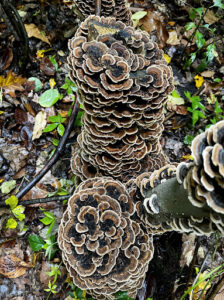News & Updates
How to Leave No Trace When Foraging


On a drizzly autumn day in West Virginia, we found ourselves trudging through ankle-deep mud as part of a Hot Spot service project. We all stopped for a snack after a few hours of trailwork, and as we took in our surroundings we noticed a perfusion of striped, fan-shaped mushrooms protruding from fallen logs all around us.
“Turkey Tail,” one of the volunteers said as he pointed with his shovel. “They’re super medicinal, I think.”
 This offhand comment stuck with us. As we left the state and carried on with our lives as a Subaru/Leave No Trace Traveling Team, we started seeing these little fungi everywhere- at our campsites, along popular trails, and even in suburban flower beds. A little research confirmed that Turkey Tail is in fact extremely medicinal, so we resolved to take the next step and learn how to harvest some for ourselves.
This offhand comment stuck with us. As we left the state and carried on with our lives as a Subaru/Leave No Trace Traveling Team, we started seeing these little fungi everywhere- at our campsites, along popular trails, and even in suburban flower beds. A little research confirmed that Turkey Tail is in fact extremely medicinal, so we resolved to take the next step and learn how to harvest some for ourselves.
We hesitated. At first glance, foraging seems to go against Leave No Trace Principle 4, “Leave What You Find,” but this is not necessarily the case. This principle is primarily aimed at preventing souvenir collection that removes objects from their natural environment without purpose or care, but the Leave No Trace spectrum allows plenty of room for sustainable and ethical foraging. If done respectfully, foraging can yield a bountiful harvest for the forager while ensuring that these natural resources remain healthy and abundant for those who follow.
How to Forage the Leave No Trace Way

Plan Ahead and Prepare
Sustainable foraging requires a wealth of knowledge to be successful. Consulting experts, guidebooks, and doing thorough online research should be given top priority when preparing for a foraging expedition.The stakes can be life or death!
Beyond the imperative ability to correctly identify the desired plant, foragers must also possess a detailed understanding of their craft, knowing what parts of the plant to harvest, when to harvest, how to cut or remove part of the plant, and how much to leave to ensure the continued health of the plant with respect to the organism’s life cycle. Having proper equipment, like a mesh sack that allows for spores to be spread while you travel, or the appropriate knife or pruners, can make the difference between harming and promoting health in a species. Consider harvesting invasive species if possible.
It’s also important to realize that foraging is not allowed everywhere or to everyone, and where it is permitted, foraging is often restricted or requires a permit. For example, except for enrolled members in federally recognized tribes with collection permits, collecting and foraging are prohibited in national parks and wildlife refuges. Traditional gathering by Indigenous communities takes place on many public lands and is a tradition that should be respected. Such gathering is done for many reasons – religious, cultural, or ceremonial – and offers a window into the deep connection many communities have to the land. Respect native and local communities and their relationship to the land. Understanding the local rules and regulations before setting out is an absolutely essential part of Leave No Trace foraging.
Travel on Durable Surfaces
The term foraging can evoke images of tramping through uncharted wilderness, but this is not necessarily the case. We’ve noticed that all sorts of desirable plants grow in plain sight and can be harvested without leaving the trail or even your own neighborhood. However, if you do decide to go off the beaten path where permitted, make sure you’re walking on durable surfaces like dirt, pine duff, or rock to ensure the health of the ecosystem.
Forage for Litter
Walking slowly and looking keenly while foraging also gives you a special opportunity to hunt for long-forgotten litter or micro-trash. Give back to the places you love by bringing a trash bag with you and cleaning up any litter you may come across.
Leave (some of) What You Find
It’s important to remember that foraging can have cumulative impacts. If done incorrectly, it can lead to resource depletion and harm the species being foraged. Harvesting should be done with caution, leaving enough of the organism for it to recover, some for other people, and never taking more than you intend to use. As foraging grows in popularity, this is especially important since everyone should have the same opportunity to taste the fruits of success. Foraging the Leave No Trace way empowers us all to share the harvest with respect for the land and each other.
By the Subaru/Leave No Trace Traveling Teams. For over 20 years these teams have provided tangible solutions to serious issues facing our outside spaces and reach over 15 million people every year. Learn more about the important work of our mobile education teams. Proud partners of this program include Subaru of America, REI, Eagles Nest Outfitters, Thule, Fjällräven, The Coleman Company and Klean Kanteen.
Let’s protect and enjoy our natural world together
Get the latest in Leave No Trace eNews in your inbox so you can stay informed and involved.
